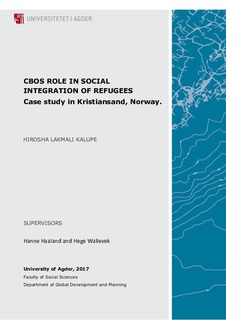| dc.contributor.author | Kalupe, Hirosha Lakmali | |
| dc.date.accessioned | 2018-04-09T10:06:18Z | |
| dc.date.available | 2018-04-09T10:06:18Z | |
| dc.date.issued | 2017 | |
| dc.identifier.uri | http://hdl.handle.net/11250/2493191 | |
| dc.description | Master's thesis Global development and planning UT505 - University of Agder 2017 | nb_NO |
| dc.description.abstract | The arrival of refugees to European countries have increased with the conflicts around the world. However, the influx of more migrants in search of safety, better lives and work in the developed world continues to create a deep social cleavage. This thesis investigates some commonly neglected dimensions of forced migration and refugee integration. It examines the challenges refugees face in their everyday lives, and how CBOs address the challenges through their social integration programs and activities. Norway has a refugee integration plan and most of the responsibilities of the integration has been given to the municipalities. Municipalities get the support from the civil society, as the refugee integration should be a bottom up plan. The thesis explores the importance of social connections, networks, the trust for increase of social capital for refugees, which helps them to overcome some of the challenges they face in their everyday life. It contributes to the theorization of social capital theory of Putnam and Fukuyama, Ager and Strang’s refugee integration model, Berry’s acculturative theory. The study feeds into the broader debate on making social bonds and bridges of the refugees’ social integration programs. My aim is to find out how these refugees accommodate to the new environment, and what are the best practices of CBOs to integrate them into the society, and the importance of social integration as a solution to their challenges they face in the host country. The thesis is divided into seven chapters. The first chapter gives the background for the research. The second chapter is explaining key concepts of the thesis. The third chapter analyses the theoretical background and literature which supports my research. The fourth chapter describes the methodology I have used in my research. The fifth chapter provides a micro-analysis of the challenges of refugees, and the sixth chapter is explaining how the selected three CBOs contribute for the refugee integration, challenges of CBOs. Finally, I summarize my research findings.
Keywords: Refugees, social integration, CBOs. | nb_NO |
| dc.language.iso | eng | nb_NO |
| dc.publisher | Universitetet i Agder ; University of Agder | nb_NO |
| dc.rights | Attribution-NonCommercial-NoDerivatives 4.0 Internasjonal | * |
| dc.rights.uri | http://creativecommons.org/licenses/by-nc-nd/4.0/deed.no | * |
| dc.subject | UT505 | nb_NO |
| dc.subject | Refugees | nb_NO |
| dc.subject | social integration | nb_NO |
| dc.subject | CBOs | nb_NO |
| dc.title | Exploring the role of CBOs in the social integration of refugees : Case study in Kristiansand, Norway | nb_NO |
| dc.type | Master thesis | nb_NO |
| dc.subject.nsi | VDP::Samfunnsvitenskap: 200::Sosiologi: 220 | nb_NO |
| dc.subject.nsi | VDP::Samfunnsvitenskap: 200::Statsvitenskap og organisasjonsteori: 240::Offentlig og privat administrasjon: 242 | nb_NO |
| dc.source.pagenumber | 115 p. | nb_NO |

